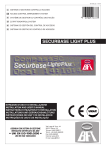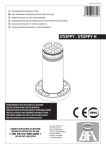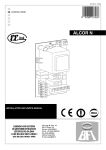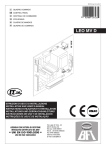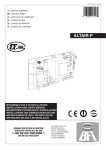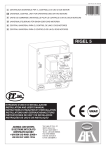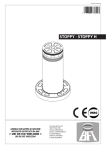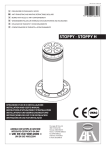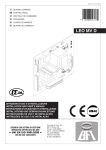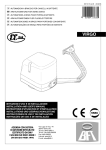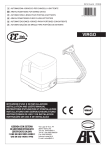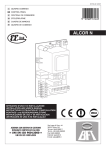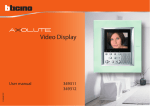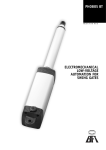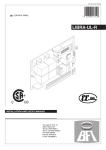Download RTD-CA TRC 1-2-4 / MITTO 2-4 433MHz
Transcript
D811373 ver.02 04-04-05 GB ROLLING-CODE / ACCESS CONTROL RADIO TRANSMITTER 8 027908 204530 RTD-CA TRC 1-2-4 / MITTO 2-4 433MHz 88 88 INSTALLATION AND USER'S MANUAL Via Lago di Vico, 44 36015 Schio (VI) Tel.naz. 0445 696511 Tel.int. +39 0445 696533 Fax 0445 696522 Internet: www.bft.it E-mail: [email protected] D811373_02 2 - RTD-CA - Ver. 02 D811373_02 MANUALE D’USO ITALIANO 1) GENERALITÀ Nel ringraziarVi per la preferenza accordata a questo prodotto, la ditta è certa che da esso otterrete le prestazioni necessarie al Vostro uso. Leggete attentamente l’opuscolo ”Libretto istruzioni” che lo accompagna in quanto esso fornisce importanti indicazioni riguardanti la sicurezza, l’installazione, l’uso e la manutenzione. Questo prodotto risponde alle norme riconosciute della tecnica e delle disposizioni relative alla sicurezza. É conforme alle seguenti direttive europee: 89/336/CEE, 1999/5/CEE e modifiche successive. Sistema radioricevente ad autoapprendimento, programmabile le cui principali caratteristiche sono: • Ricevitore a 512 o 2048 codici • Fino a 4 uscite (1 standard + 3 modulari) con riconoscimento automatico dei moduli inseriti • Uscite configurabili come monostabile, bistabile, temporizzata, antiaggressione e controllo accessi • Programmazione mediante display incorporato • Funzioni di controllo accessi • Capacità di riconoscere e memorizzare trasmettitori, tessere di prossimità, trasmettitori abilitati al controllo accessi. • Compatibile con il protocollo EElink per una rapida installazione e manutenzione. • Protezione della ricevente mediante password 2) MANUTENZIONE La manutenzione dell’impianto va fatta eseguire regolarmente da parte di personale qualificato. Le trasmittenti MITTO sono alimentate da 2 batterie al litio da 3V (tipo CR2016). Le trasmittenti TRC sono alimentate da una batteria alcalina da 12V. Una diminuzione della portata della trasmittente può essere dovuta alle batterie che si stanno scaricando. Quando il led della trasmittente lampeggia, indica che le batterie sono scariche e devono essere sostituite. 3) DEMOLIZIONE ATTENZIONE: Avvalersi esclusivamente di personale qualificato. L’eliminazione dei materiali va fatta rispettando le norme vigenti. Nel caso di demolizione del sistema, non esistono particolari pericoli o rischi derivanti dai componenti stessi. È opportuno, in caso di recupero dei materiali, che vengano separati per tipologia (parti elettriche - rame alluminio - plastica - ecc.). Per lo smaltimento della batteria riferirsi alla normativa vigente. USER’S MANUAL ENGLISH 1) GENERAL OUTLINE Thank you for buying this product, our company is sure that you will be more than satisfied with the performance of the product. Read the “Instruction Manual” supplied with this product carefully, as it provides important information about safety, installation, operation and maintenance.This product conforms to recognised technical standards and safety regulations. It complies with the 89/336/EEC, 1999/5/CEE, European Directive and subsequent amendments. Programmable self-learning radio receiver system, having the following main features: • Receiver with 512 or 2048 codes • Up to 4 outputs (1 standard + 3 modular) with automatic recognition of the modules entered • Outputs which can be configured as monostable, bistable, timed, anti-aggression and access control • Programming by means of incorporated display • Access control functions by means of integrated WRTD board • Capable of recognising and memorising transmitters, proximity cards, and transmitters enabled for access control • Compatible with EElink protocol for fast installation and maintenance • Protection of receiver by means of password. 2) MAINTENANCE The maintenance of the system should only be carried out by qualified personnel regularly. The MITTO transmitters are supplied by two 3V lithium battiers (type CR2016). The TRC transmitters are powered by a 12V alkaline battery. Any reduction in the transmitter capacity may be due to the batteries getting flat. When the led of the transmitter flashes, it means that the batteries are flat and must be replaced. 3) DISPOSAL ATTENTION: disposal should only be carried out by qualified personnel. Materials must be disposed of in conformity with the current regulations. In case of disposal, the system components do not entail any particular risks or danger. In case of recovered materials, these should be sorted out by type (electrical components, copper, aluminium, plastic etc.). For battery disposal, refer to the current regulations. RTD-CA - Ver. 02 - 3 INSTALLATION MANUAL Thank you for buying this product, our company is sure that you will be more than satisfied with the product’s performance. The product is supplied with a “Warnings” leaflet and an “Instruction booklet”. These should both be read carefully as they provide important information about safety, installation, operation and maintenance. This product complies with the recognised technical standards and safety regulations. We declare that this product is in conformity with the following European Directives: 89/336/EEC and 73/23/EEC (and subsequent amendments). GENERAL SAFETY WARNING! An incorrect installation or improper use of the product can cause damage to persons, animals or things. • The “Warnings” leaflet and “Instruction booklet” supplied with this product should be read carefully as they provide important information about safety, installation, use and maintenance. • Scrap packing materials (plastic, cardboard, polystyrene etc) according to the provisions set out by current standards. Keep nylon or polystyrene bags out of children’s reach. • Keep the instructions together with the technical brochure for future reference. • This product was exclusively designed and manufactured for the use specified in the present documentation. Any other use not specified in this documentation could damage the product and be dangerous. • The Company declines all responsibility for any consequences resulting from improper use of the product, or use which is different from that expected and specified in the present documentation. • Do not install the product in explosive atmosphere. • The construction components of this product must comply with the following European Directives:It complies with the 89/336/EEC, 1999/5/CEE, European Directive and subsequent amendments. As for all non-EEC countries, the above-mentioned standards as well as the current national standards should be respected in order to achieve a good safety level. • The Company declines all responsibility for any consequences resulting from failure to observe Good Technical Practice when constructing closing structures (door, gates etc.), as well as from any deformation which might occur during use. • The installation must comply with the provisions set out by the following European Directives:It complies with the 89/336/EEC, 1999/5/CEE, European Directive and subsequent amendments. • Disconnect the electrical power supply before carrying out any work on the installation. Also disconnect any buffer batteries, if fitted. • Fit an omnipolar or magnetothermal switch on the mains power supply, having a contact opening distance equal to or greater than 3,5 mm. • Check that a differential switch with a 0.03A threshold is fitted just before the power supply mains. • Check that earthing is carried out correctly: connect all metal parts for closure (doors, gates etc.) and all system components provided with an earth terminal. • Fit all the safety devices (photocells, electric edges etc.) which are needed to protect the area from any danger caused by squashing, conveying and shearing. • Position at least one luminous signal indication device (blinker) where it can be easily seen, and fix a Warning sign to the structure. • The Company declines all responsibility with respect to the automation safety and correct operation when other manufacturers’ components are used. • Only use original parts for any maintenance or repair operation. • Do not modify the automation components, unless explicitly authorised by the company. • Instruct the product user about the control systems provided and the manual opening operation in case of emergency. • Do not allow persons or children to remain in the automation operation area. • Keep radio control or other control devices out of children’s reach, in order to avoid unintentional automation activation. • The user must avoid any attempt to carry out work or repair on the automation system, and always request the assistance of qualified personnel. 12 - RTD-CA - Ver. 02 • • Anything which is not expressly provided for in the present instructions, is not allowed. Installation must be carried out using the safety devices and controls prescribed by the EN 12978 Standard. 1) GENERAL OUTLINE Programmable self-learning radio receiver system, having the following main features: • Receiver with 512 or 2048 codes • Up to 4 outputs (1 standard + 3 modular) with automatic recognition of the modules entered • Outputs which can be configured as monostable, bistable, timed, anti-aggression and access control • Programming by means of incorporated display • Access control functions by means of integrated WRTD board • Capable of recognising and memorising transmitters, proximity cards, and transmitters enabled for access control • Compatible with EElink protocol for fast installation and maintenance • Protection of receiver by means of password. The integration of the receiver system, having transmitter cloning and access control functions, provides a wide range of installations. It allows the management of up to 4 passageways by means of radio transmitters (MITTO/TRC) as well as transponders (Compass-Isocard/ Compass-Ring/MITTO T). The radio transmitters (MITTO/TRC) can be managed by the RTD-CA system, both as traditional radio transmitters and as proximity cards. Using the COMPASS-232 optional interface, the system can be monitored by the SECURBASE access control software (optional) which provides full access control. Passageway control is managed by an output with N.O. contact; when needed, the number of outputs can be increased by means of appropriate MOP optional modules to obtain a maximum of 4 output channels, which can be configured independently. 2) TECHNICAL SPECIFICATIONS 2.1) RTD-CA Receiver Power supply: ....................................................... 230V ±10%50Hz Frequency: ....................................................................... 433.92MHz Working temperature: .................................................... -20 to +55°C Coded by means of: ....................................... Rolling-code algorithm No. combinations: ................................................................ 4 milliard Antenna impedance: .................................................. 50Ohm (RG58) Dimensions: .......................................................................... see fig. 1 Relay contact: .................................................................. 0,5A - 12V= Degree of protection: ................................................................ IP 20* (*) The degree of protection of the container becomes IP55 with the use of an accessory supplied on request. Only use fittings suitable for the container dimensions and cable diameter. 2.2) WRTD board • Access to proximity card / transmitters enabled • The system parameters and code map are stored in a non-volatile memory, which can keep the data entered for years, even with the power supply disconnected. • The memory can manage up to 819 cards (RTD-CA 512) or 2500 cards (RTD-CA 2048). • The door-opening time can be freely set from 0 to 25.5 seconds. • The door-open control time can be freely set from 0 to 255 seconds. 2.3) MITTO transmitter Keys: .......................................................................................... yellow Power supply: 2 .......................... 3V lithium batteries (CR2016 type) Range: ..................................................................... 50 – 100 metres Transmitter versions: MITTO2 – double-channel, MITTO4 – four-channel. 2.4) TRC transmitter Keys: ............................................................................................... red Power supply: ...................................................... 12V alkaline battery Range: ..................................................................... 50 – 100 metres Transmitter versions: TRC1– single-channel, TRC2– double-channel, TRC4 – four-channel D811373_02 ENGLISH D811373_02 INSTALLATION MANUAL Accessories (optional): COMPASS-READER: Proximity card reader COMPASS-ISOCARD: ISO-standard proximity card, can be personalised (photos, personal details etc.) COMPASS-RING: Key holder with transponder, provided with the same functions as the card MITTO2-T/MITTO4-T: Rolling-code transmitter with transponder, provided with the same functions as the card COMPASS-232: Serial converter for connection of up to 19 RTD-CAs to the PC serial port SECURBASE: Access control management database on PC Complete data file management of: cards, readers, time bands, calendar, antipassback, and card self-learning WARNING: The software can manage up to 20 outputs configured in the receiver as access control outputs. The maximum number of RTDCAs which can be managed therefore depends on the number of outputs configured for access control on each receiver. MOP Plug-in module provided with an additional output with N.O. contact. 3) INSTALLATION Having laid out the connection cable route, proceed to fixing the support (fig. 1) after marking the two holes through the slots available as templates on the container. Based on the material the support is made of, directly use the screws supplied or drill the holes using a 4mm-diameter bit to insert the plugs supplied. Fully tighten the screws, and compensate any centring errors using the slots on the container. WARNING! The RTD-CA control board activates door opening by means of a relay. A safe installation therefore requires the RTD-CA board to be positioned inside the building, in an area protected against break-in. Any Compass-Reader transponder readers can be positioned outside the building, given that they cannot control door opening, even in the case of tampering. 4) CONNECTION DIAGRAM Various types of installation are possible depending on the number of outputs available and the functions required by the system. Fig. 2 shows the terminal bars present in the RTD-CA receiver and in the WRTD access control module. Fig. 3 shows the wiring diagram of a typical installation. Fig. 4 shows the connections needed between RTD-CA, Compass232 and Compass-Reader in installations managed by Securbase. RTD-CA JP4 ±10% 50/60Hz(1L-2N) 1-2 Power supply input 230 V JP3 3 Output for COM common contact 4 Output for NO normally open contact. Contact for door opening control JP2 5-6 Input for antenna (5 signal – 6 braid) WRTD JP6 (COMPASS-READER connection) 1 + Power supply 2 D1 3 DØ 4 0 Power supply 5 LED A 6 LED B Receives the data of the card presented from the COMPASS-READER. Up to 2 Compass-Readers can be connected in parallel to each WRTD. JP3 ENGLISH 7-8 RS 485 serial connection (7-B, 8-A) Allow serial connection of several RTD-CAs in systems interfaced by means of Compass-232 to the COM serial port of a PC. It is advisable not to exceed a maximum connection length of 500 m. JP5 13-12 Door status input OUT1 (N.C.) 13-11 Door status input OUT2 (N.C.) 13-10 Door status input OUT3 (N.C.) 13-9 Door status input OUT4 (N.C.) Inputs for checking door closing status JP4 14-15-16 Alarm 14-NC, 15-NO, 16-COM Exchange contact for alarm control; if, after being opened, the door is not closed within the set “door-open control time”, commutation takes place between NC and NO contact. MOP (optional) JP1 1-2 Output for NO normally open contact. Contact for door opening control. ANTENNA INSTALLATION Use an antenna tuned to 433MHz. For antenna to receiver connection, use RG8 coaxial cable. The presence of metallic masses next to the antenna can interfere with radio reception. In the case of insufficient transmitter range, move the antenna to a more suitable position. 5) PROGRAMMING The RTD-CA receiver combines radio receiver functions with access control functions. If an output is configured for access control, the Add menu is automatically set to receive cards or transmitters to be enabled and managed in the access control mode. In the case where you wish to use the transmitters (MITTO/TRC) as access control cards, you must remember that each key (T1, T2, T3 or T4) corresponds to a card code. A wide range of installations can therefore be obtained, where each RTD-CA receiver can have certain outputs configured as access controls and others configured as radio transmitters. As an example, the installation diagram in fig. 3 is configured as follows: OUT1 – Standard radio transmitter output associated with the T1 key OUT2 – Standard radio transmitter output associated with the T2 key OUT3 - Access control output associated with key T3 of the transmitter which, in this case, has been memorised as a transmitter enabled for access control. Card code reception takes place via radio. OUT4 - Access control output managed by a Compass-Reader. This passageway is controlled by proximity cards (Compass-Isocard/ Compass-Ring) or by the transponder present in MITTO T. In the case of complex installations, it is advisable to lay out a preliminary general wiring diagram. For these types of installation, the antenna position is to chosen with great care, keeping in mind that the transmitters can control more than one passageway, as long as they are within the antenna reception area. NOTE: In order to be enabled and managed by the RTD-CA access control system, a transmitter must necessarily be a clone of the first transmitter entered (see paragraph 5.1). Cloning of a transmitter does not involve automatic activation of the outputs configured in radio transmitter mode (outputs OUT1 and OUT2 for example). These transmitters should be entered in the receiver manually. 5.1) TRANSMITTERS ENABLED FOR ACCESS CONTROL To enable transmitters for access control, observe one of the following two procedures: If no transmitter has been entered in the receiver: Enter a first transmitter in an output of your choice, as long as this is not configured as access control, in order to assign a receiver code to the RTD-CA. Subsequently, use UNIRADIO to clone this first “master” transmitter to create all the transmitters to be entered later in access control management. Make reference to the “configuration” menu, the “add” menu, and to RTD-CA - Ver. 02 - 13 INSTALLATION MANUAL section 6 “Additional cloning with master”. IMPORTANT NOTE: STICK THE KEY LABEL (MASTER) ON THE FIRST MEMORISED TRANSMITTER. If a key transmitter has already been entered in the receiver, and the transmitter is not available: Use UNIRADIO to read the code entered in the receiver (see section 6 “Code reading”). Subsequently, create all the transmitters to be entered later in access control management, as indicated in section “Additional cloning with code”. The code number assigned will allow the creation and cloning of other enabled transmitters at any time; it is therefore advisable to write it down on the appropriate card supplied before giving it to the user (fig. 7). Make reference to the UNIRADIO Instructions for further information. 5.2) PROGRAMMING MENU DESCRIPTION Add: Allows you to add a transmitter, a card or a transmitter enabled for access control to a receiver memory. Two modes are possible: Auto: the transmitter or the card is entered in the first memory location available. Manual: the number of the memory location where to enter the transmitter or the card is requested. This mode turns out to be useful in the case where you wish to assign progressive numbers to the various transmitters/cards, in order to simplify any subsequent elimination from the receiver memory. After selecting the automatic mode, proceed as follows: 1) Use the + and – buttons to select the output you wish to activate. 2) If the output is configured as monostable, bistable, timed or antiaggression (menu Add 1, Fig.A): Press hidden key P1 on the transmitter, and then press the transmitter key (T1, T2, T3 or T4) you wish to associate with the previously selected output. 3) If the output is configured as access control (menu Add 2, Fig.A): Present the Compass-Reader with a card to be enabled or press a key (T1, T2, T3 or T4) of an enabled transmitter (see section “TRANSMITTERS ENABLED FOR ACCESS CONTROL”). Note: Hidden key P1 has a different function depending on the transmitter model. For TRC 1-2 / MITTO 2-4, press hidden key P1 (fig. B1A). For TRC 4, the key P1 function corresponds to simultaneously pressing the 4 transmitter keys or, after opening the battery compartment, bridging the two P1 points by means of a screwdriver (fig. B1A). Delete: Allows you to delete one or all the entered transmitters/cards from the receiver memory. Codes: allows you to eliminate a transmitter/card from the receiver memory by entering the memory position number (see Add-manual menu). Database: allows you to eliminate ALL the transmitters and transponders from the receiver memory. You will be asked to confirm this operation in order to avoid unwanted deletions. Note: in this menu, the transmitters are indicated by the letter “R” (ex. R002), the enabled cards and radio transmitters are indicated by the letter “T” (ex. T012). Verify: Allows you to check the presence of a transmitter/card in the memory, or to display the whole list. Read code: requires you to press a key on the transmitter, or to present the enabled card or radio transmitter. If memorised, it displays the memory location number and key number in the case of transmitters, or the location number followed by the “transp” message in the case of enabled cards/transmitters. Scroll archive: press the + and - buttons to scroll the list of all the radio transmitters/cards memorised; keep the button pressed to speed up list scrolling. Output: Allows you to configure the functions of the outputs available in the 14 - RTD-CA - Ver. 02 receiver. Configure outputs 1, 2, 3 and 4: select the output you wish to configure using the + and – buttons. Each output can be configured according to the following modes: 1) impulse (monostable). The relay of the associated output remains picked up as long as the respective transmitter key remains pressed. 2) step by step (bistable). The relay of the associated output changes status each time the transmitter key is pressed. 3) timed. Each time the transmitter key is pressed, the output relay stays picked up for 90 seconds. If the key is pressed during the count cycle, the count is reset. 4) antipanic. he relay of the associated output changes status if the key is kept pressed for more than 5 seconds. All the keys of all the transmitters entered in the receiver are automatically provided with the anti-aggression function, regardless of their configuration, therefore no key (T1, T2, T3 or T4) needs to be assigned to the output. Relay commutation lasts 10 sec. 5) access control. The relay of the associated output only changes status after an enabled card is presented or an enabled transmitter code is received. Setting an output in access control mode requires the following parameters to be configured as described below. Type of access: with PC: the output is configured to be managed by the Securbase access control software (fig. 4-5). Recognition and enabling of a card or a transmitter are carried out by means of remote control. stand alone: the output is configured to be managed without the Securbase software. Recognition and enabling of a card or a transmitter are carried out by means of the RTD receiver. free: the output changes status after receiving any card code (enabled or not enabled) forbidden: the output is locked (door always closed) system reader: to be used when the Securbase database is present. If configured as a system reader, the receiver is preset for entering enabled cards and transmitters in sequence. For practical reasons, it is advisable to set an RTD-CA receiver, provided with a Compass-Reader next to the PC, as a system reader. In order to enter the enabled transmitters in sequence, it is indispensable to configure an RTD-CA as a system reader. Door relay time (watchdog): use the +/- keys to increase or decrease the value of the door relay pickup following reception of a valid card or transmitter. The value is expressed in tenths of seconds, ranging from 0 to 25.5 seconds. If the value is set to 0, the relay remains picked up until the door is closed again. Door control time: use the +/- keys to increase or decrease the value of the door control time. The value is expressed in seconds, ranging from 0 to 255 seconds. If the door status control contact corresponding to the output is not closed within this period of time, it causes alarm relay commutation which persists until the contact is closed. If the door control time is set to 0, the function is disabled. Address: use the +/- keys to set the communication address (polling) on the 485 serial line. This is to be used in the case where more than one access control output is connected to the serial line. Each output configured for access control must have a univocal address included between 0 and 19. The presence of two outputs with the same address produces software conflicts. The default address is 1 for output 1, 2 for output 2, 3 for output 3, and 4 for output 4. The address is irrelevant in the case of stand-alone systems. Notes: 1) The default outputs are configured as monostable. Only one output can be configured with anti-aggression mode. 2) In the case where it is necessary to check the mode of an output D811373_02 ENGLISH D811373_02 INSTALLATION MANUAL configuration, select the output and press the OK key. The receiver displays the previously set function mode as the first option. 3) If you try to configure an output which is not provided with a MOP optional module, the “module not present” error message will be displayed. 4) In the case of PC operation malfunctions, or any communication failure between Securbase and RTD-CA, the RTD-CA receiver stand-alone functions remain active, so the receiver can continue to check the cards recorded in its memory. It is therefore advisable to copy the most frequently used or most important cards from the Securbase database to the RTD-CA memory. Make reference to the Securbase Instructions for further information. 5) The following table indicates the memory capacity of the RTD-CA versions: RTD-CA Max. no. cards or Max. no. Total transmitters enabled transmitters 512 819 512 819 2048 2500 2048 3270 Each storage takes up a memory location, regardless of the type of device entered, therefore if for example 400 transmitters are stored in the memory of an RTD-CA 512, 419 locations will be left available to memorise the cards (819-400=419). Configure RTD-CA: Allows you to set the general system functions. Language: select one of the languages available (Italian, French, German, English, Spanish). Password: use the + and - buttons to enter a password consisting of 4 digits (from 0 to 9). If a value other than the default value (0000) is entered, the access password will be requested for the subsequent configuration attempt. If you do not wish to protect receiver programming by means of a password, re-enter default value 0000. 6) RADIO TRANSMITTER CLONING ADDITIONAL CLONING WITH MASTER For practical clone generation by means of the master transmitter (marked by the key label), refer to the instructions on the UNIRADIO device or observe the following simplified procedure: 1) Switch UNIRADIO on and wait for the welcome message. 2) Use the <arrow up> and <arrow down> keys to select item <go the menu number>. 3) Press <enter>. 4) When in the subsequent menu, type number 2122 and press <enter>. 5) Follow the instructions appearing on the UNIRADIO display. CODE READING In the case where a receiver code in not known, reading can be obtained by proceeding in the following way: 1) Switch UNIRADIO on and wait for the welcome message. 2) Use the <arrow up> and <arrow down> keys to select item <go the menu number>. 3) Press <enter>. 4) When in the subsequent menu, type number 225 and press <enter>. 5) Follow the instructions appearing on the UNIRADIO display. ADDITIONAL CLONING WITH CODE Once the key code has been read, it is advisable to write it down on the appropriate card supplied before giving it to the user (fig. 7). For practical clone generation, refer to the instructions on the UNIRADIO device or, for additional clones, observe the following simplified procedure: 1) Switch UNIRADIO on and wait for the welcome message. 2) Use the <arrow up> and <arrow down> keys to select item <go the menu number>. 3) Press <enter>. 4) When in the subsequent menu, type number 2121 and press <enter>. 5) Follow the instructions appearing on the UNIRADIO display. The UNIRADIO device (Fig.6) also allows to read and copy the lists of the transmitters memorised from one RTD-CA to another. On the other hand, the UNIRADIO device does not allow to modify the ENGLISH lists. UNIPRO does not support the RTD-CA output configuration. The receiver does not supply the UNIPRO programmer, which therefore requires an appropriate supply unit or charged batteries. 7) CONNECTION TO PC The RTD-CA system can be interfaced with a personal computer for access monitoring (fig. 4-5). In this case the following accessories are required: COMPASS-232 Interface for PC: provides serial connection between RTD-CA and PC. A maximum number of 20 outputs can be managed. NOTE: Connect a 120 Ohm/0,25W resistor between terminals 7 and 8 on the farthest RTD-CA along the line, as shown in fig. 5. SECURBASE Monitoring software, having the following main functions: • Increase in the maximum number of cards which can be memorised and managed (with the only limitation of the PC memory) • Use of access enabling time bands (the user can only have access within a specified time band) • Use of access enabling calendar (the user can only have access in predefined days). • Anti-passback: by installing an additional RTD-CA/CompassReader set in output, you can check that a card has been taken out • Real-time display of accesses • Real-time display of card owner’s personal details • Possible setting of parameters of connected readers • Access recording with possible search and printout. Card management in Securbase takes place by means of a system reader, consisting of any RTD-CA/Compass-Reader set. See Configuration, Access control and System reader menus. COMPASS READER The Compass-Reader proximity card reader is provided with a LED which changes colour depending on the output status: Green: access free or opening contact picked up Red: access forbidden Yellow: normal operation (waiting for code) Yellow, blinking: waiting for Securbase enquiry Yellow/Green, blinking: system reader If more than one exit is configured for access control, the LED will only respond to the status of output 4. It is however possible to control more than one RTD-CA output using a single Compass-Reader. This function turns out to be particularly useful in the case of close-up access points, where separate card groups can be enabled for each RTD-CA output. 8) MAINTENANCE The maintenance of the system should only be carried out by qualified personnel regularly. The MITTO transmitters are supplied by two 3V lithium battiers (type CR2016).The TRC transmitters are powered by a 12V alkaline battery.When replacing the batteries type CR2016 do not touch the poles with thehands. Any reduction in the transmitter capacity may be due to the batteries getting flat. When the led of the transmitter flashes, it means that the batteries are flat and must be replaced. 9) DISPOSAL ATTENTION: disposal should only be carried out by qualified personnel. Materials must be disposed of in conformity with the current regulations. In case of disposal, the system components do not entail any particular risks or danger. In case of recovered materials, these should be sorted out by type (electrical components, copper, aluminium, plastic etc.). For battery disposal, refer to the current regulations. The descriptions and illustrations contained in the present manual are not binding. The Company reserves the right to make any alterations deemed appropriate for the technical, manufacturing and commercial improvement of the product, while leaving its essential features unchanged, at any time and without undertaking to update the present publication. RTD-CA - Ver. 02 - 15 LEGENDA ACCESS TO MENUS +/- 8888 Press the OK key OK + OK BFT RTD1.0 00 [ 00 ] Software version PRG Preset value /ON /OFF No. radio control devices memorised OK Parameter increment/reduction or ON/OFF commutation Message: Programming in progress Message: KO! (value or function error) Menu scrolling (+ = preceding - = following) - + Simultaneously press the + and - keys. Simultaneous pressure of the + and – keys allows you to exit the active menu and return to the preceding menu; if this takes place at the main menu level, programming is exited and the display switched off. The modifications made are only confirmed if the OK key is subsequently pressed. Message: “Wait” (enter value or function) +/ADD 1 - RADIO RECEIVER OUT out1 . .4 aut. OK - + +/- man. out1 . .4 pos. OK hidden button desired button END - + 2 -ACCESS CONTROL OUT +/add OK aut. out1 . .4 activate code out1 . .4 pos. - + +/- man. OK attiva codice END +/delete OK code POS. +/- database END r0001 . . . t618 - + confirm OK - + +/verifiy OK read code 01 t1 . . . 2048 t4 - + +/- + END FOLLOWING MENUS FIG. B 16 - RTD-CA - Ver. 02 scroll archive 01 t1 . . . 2048 t4 OK D811373_02 Fig. A D811373_02 Fig. B FIG. B2A FIG. B1A P1 PRECEDING MENUS FIG. A T1 T2 T1 T2 P1 T1 T2 T3 T4 T1 TRC 1-2 TRC 4 monos OK T2 T3 T4 MITTO 2-4 TRC 4 TRC 1-2 +/output OK +/END out1 OK - + - + out 2 bist - + - + out 3 timed - + - + out 4 antipanic - + - + access contr. access type pc conn. OK - + - + door time - + 0000 . . . 2500 OK stand-alone - + 0000 . . . 0025 OK free - + 0000 . . . 0019 OK - + - + vatchdog - + - + address forbidden - + system reader +/confige RTD language ita OK - + +/- fra - + END deu - + - + ENG - + ESP password 0--- -0-- --0- ---0 OK RTD-CA - Ver. 02 - 17 44 35 T2 T1 75 75 T1 12.5 T1 T2 T1 T4 T2 T2 82 65 T3 T3 16 16 T4 45 16 45 MITTO 2 TRC 1-2 MITTO 4 34 10 1 147 42 - RTD-CA - Ver. 02 TRC4 18.5 D811373_02 Fig. 1 D811373_02 RTD-CA - Ver. 02 - 43 2x 4 mm 6x0,5 T OU 2 + 1 mm 2 A 8 RG5 T3 OU 85 - RS4 2 2x1,5 T3- OUT3 m 2x1m 5mm2 2x0, 2 2x1m m2 RTD-CA mm m2 1m 44 - RTD-CA - Ver. 02 2x COMPASS READER OU T 1 T2- OUT2 T1- OUT1 D811373_02 Fig. 3 OUT2 D811373_02 Fig. 4 6x0,5mm MAX. 5 m COMPASS READER 1 id 1 SecurBase RTD-CA 1 COM 6x0,5mm MAX. 5 m COMPASS READER 2 2 RTD-CA 2 RS-232 MAX. 3 m id 6x0,5mm MAX. 5 m COMPASS READER 3 id 3 COMPASS 485 1 COMPASS 232 id 0 COMPASS READER 0 6x0,5mm MAX. 5 m COMPASS READER 19 id AREA SORVEGLIATA AREA UNDER SURVEILLANCE GESCHÜZTER BEREICH ZONE SURVEILLÉE ÁREA VIGILADA ZONA VIGIADA COMPASS 485 19 6x0,5mm MAX. 5 m COMPASS 232 7 8 1 2 3 4 5 6 12 11 10 7 8 1 2 3 4 5 6 JP3 6 JP6 5 13 12 11 10 9 WRTD ... JP3 4 JP6 2 3 WRTD 2 JP3 JP6 1 16 15 14 JP5 WRTD 1 13 12 11 10 9 JP4 16 15 14 JP5 13 12 11 10 9 JP4 JP5 JP4 16 15 14 18 17 16 15 14 13 7 8 9 8 2x0,5mm MAX. 500 m RTD-CA - Ver. 02 - 45 D811373_02 Fig. 5 RS 232 MAX. 3m SecurBase COM RS-232 RS-232 18 17 16 15 14 13 1 2 3 4 5 6 7 8 COMPASS 232 SECURBASE 0,1AT 12 11 10 COMPASS 232 9 8 JP1a 1 2 7 8 1 2 3 4 5 6 7 8 1 2 3 4 5 6 JP3 6 JP6 5 13 12 11 10 9 WRTD ... JP3 4 JP6 2 3 WRTD 2 JP3 JP6 1 16 15 14 JP5 WRTD 1 13 12 11 10 9 JP4 16 15 14 JP5 13 12 11 10 9 JP1b JP4 JP5 JP4 16 15 14 3 4 5 6 7 7 8 120Ω 0,25W Marrone/Brown/Brun/Braun/Marròn/Castanho Rosso/Red/Rouges/Rot/Rojos/Vermelos Marrone/Brown/Brun/Braun/Marròn/Castanho JP6 120Ω/0,25W 16 15 14 JP5 JP4 RTD-CA 13 12 11 10 9 WRTD 1 46 - RTD-CA - Ver. 02 4 LED B +12 V D1 DØ 0V LED A +12 V D1 DØ 0V LED A LED B COMPASS-READER 2 3 6 5 4 3 2 1 COMPASS-READER 5 6 JP3 JP6 6 5 4 3 2 1 1 7 8 1 - + 12V 2 - D1 3 - DØ 4 - 0V 5 - LEDA 6 - LEDB D811373_02 Fig. 6 C4 TR P1 T1 T1 2 T 3 T 4 T TRC 1-2 T2 Led MITTO 2-4 P1 P1 P1 RTD-CA UNIRADIO UNIFLAT 88 88 Contatti Contacts Contacts Kontakte Contactos Contatos UNIFLAT WRTD UNITRC UNIFLAT UNIFLAT UNIMITTO TRC1-2 Contatti Contacts Contacts Kontakte Contactos Contatos Contatti Contacts Contacts Kontakte Contactos Contatos TRC4 UNITRC UNITRC TRC1-2 TRC4 MITTO 2-4 2 UNIMITTO 1 3 1 4 2 3 4 RTD-CA - Ver. 02 - 47 D811373_02 Fig. 7 Fig. 8 UNIRADIO MITTO 2-4 1 D-0 2F C-2 1A9 Contatti Contacts Contacts Kontakte Contactos Contatos P1 OK! 48 - RTD-CA - Ver. 02


















